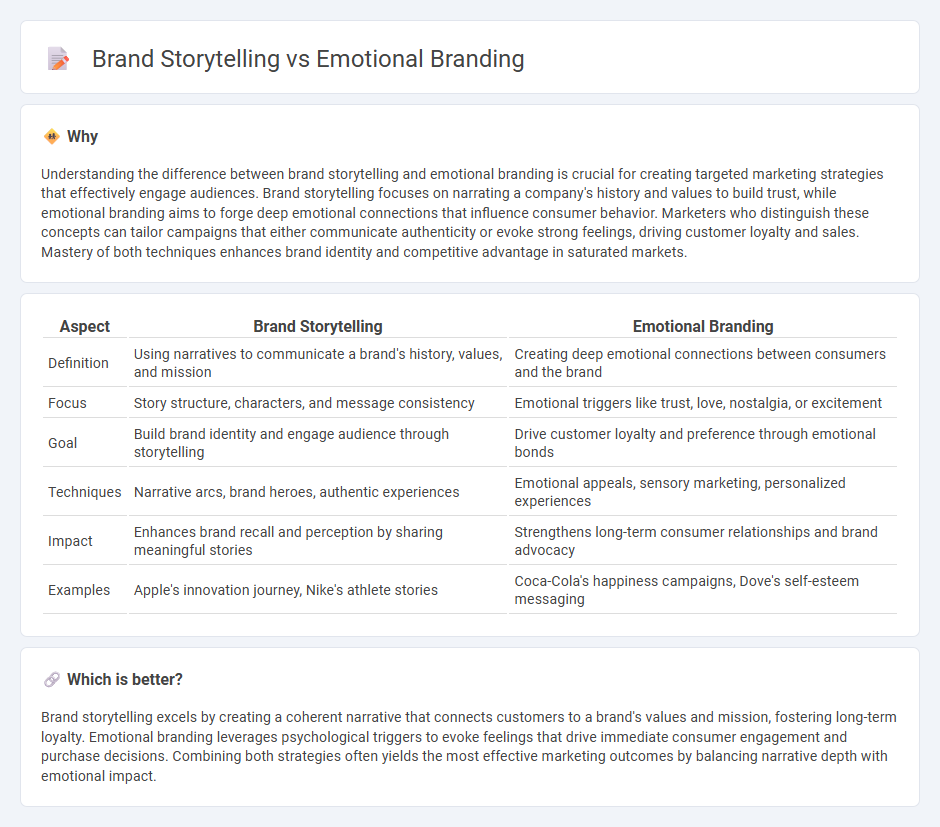
Brand storytelling creates a compelling narrative that connects consumers to a brand's mission and values, fostering loyalty through relatable and authentic experiences. Emotional branding targets specific feelings to build deep, lasting bonds, influencing purchasing decisions by tapping into consumers' desires and aspirations. Discover how both strategies can transform your marketing approach and drive engagement.
Why it is important
Understanding the difference between brand storytelling and emotional branding is crucial for creating targeted marketing strategies that effectively engage audiences. Brand storytelling focuses on narrating a company's history and values to build trust, while emotional branding aims to forge deep emotional connections that influence consumer behavior. Marketers who distinguish these concepts can tailor campaigns that either communicate authenticity or evoke strong feelings, driving customer loyalty and sales. Mastery of both techniques enhances brand identity and competitive advantage in saturated markets.
Comparison Table
| Aspect | Brand Storytelling | Emotional Branding |
|---|---|---|
| Definition | Using narratives to communicate a brand's history, values, and mission | Creating deep emotional connections between consumers and the brand |
| Focus | Story structure, characters, and message consistency | Emotional triggers like trust, love, nostalgia, or excitement |
| Goal | Build brand identity and engage audience through storytelling | Drive customer loyalty and preference through emotional bonds |
| Techniques | Narrative arcs, brand heroes, authentic experiences | Emotional appeals, sensory marketing, personalized experiences |
| Impact | Enhances brand recall and perception by sharing meaningful stories | Strengthens long-term consumer relationships and brand advocacy |
| Examples | Apple's innovation journey, Nike's athlete stories | Coca-Cola's happiness campaigns, Dove's self-esteem messaging |
Which is better?
Brand storytelling excels by creating a coherent narrative that connects customers to a brand's values and mission, fostering long-term loyalty. Emotional branding leverages psychological triggers to evoke feelings that drive immediate consumer engagement and purchase decisions. Combining both strategies often yields the most effective marketing outcomes by balancing narrative depth with emotional impact.
Connection
Brand storytelling and emotional branding are deeply connected through their shared goal of creating meaningful connections between consumers and brands by leveraging narratives that evoke feelings. Emotional branding taps into core human emotions to foster loyalty and trust, while brand storytelling provides the structured narrative framework that conveys these emotions effectively. Together, they build powerful brand identities that resonate on a personal level, driving engagement and long-term customer relationships.
Key Terms
**Emotional Branding:**
Emotional branding leverages deep psychological connections to create lasting consumer loyalty by evoking feelings such as trust, happiness, or nostalgia. This strategy prioritizes building a strong emotional resonance with the audience, often through sensory experiences, personalized messaging, and consistent brand values. Discover how emotional branding transforms customer relationships and strengthens brand identity.
Brand Attachment
Emotional branding builds deep connections by evoking feelings that foster brand attachment, while brand storytelling uses narratives to create relatable experiences that engage consumers. Brand attachment strengthens customer loyalty and increases lifetime value by making the brand personally meaningful. Discover the key strategies to enhance brand attachment through emotional branding and storytelling techniques.
Emotional Resonance
Emotional branding centers on creating a deep emotional connection with consumers by tapping into feelings such as trust, joy, or nostalgia to foster brand loyalty. Brand storytelling uses narratives and authentic experiences to communicate the brand's values, history, and mission, engaging audiences through relatable stories. Discover how emotional resonance can elevate your brand's impact and cultivate lasting customer relationships.
Source and External Links
Emotional branding - Emotional branding is a marketing approach that appeals directly to consumers' emotional states, needs, and aspirations to create strong, lasting attachments to brands, turning consumer relationships into feelings of bonding or love.
Emotional Branding: Benefits & Examples - Ramotion - Emotional branding focuses on triggering emotional responses in consumers to build strong brand loyalty and drives positive engagement by connecting with customer emotions such as happiness, belonging, and inspiration through campaigns and design.
The Neuroscience of Emotional Branding - ThoughtLab - Emotional branding leverages neuroscience by creating emotionally charged experiences that trigger dopamine release, cementing memories and building lasting consumer loyalty beyond transactional interactions.
 dowidth.com
dowidth.com